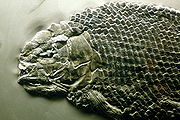
Lepidotes
Encyclopedia
Lepidotes is an extinct genus of neopterygian
ray-finned fish from the Jurassic
and Cretaceous
periods. Fossils have been found worldwide.
 Inhabiting both freshwater lakes and shallow seas, Lepidotes was typically about 30 centimetres (11.8 in) long. The body was covered with thick, enamelled scales
Inhabiting both freshwater lakes and shallow seas, Lepidotes was typically about 30 centimetres (11.8 in) long. The body was covered with thick, enamelled scales
. Batteries of peg-like teeth enabled Lepidotes to crush the shells of its molluscan prey.
 Lepidotes was one of the earliest fish in which the upper jawbones were no longer attached to the jugal bone
Lepidotes was one of the earliest fish in which the upper jawbones were no longer attached to the jugal bone
. This allowed the jaws to be stretched into a 'tube' so that the fish could suck in prey from a greater distance than in previous species. This system is still seen in some modern fish, such as carp
.
Lepidotes is frequently pictured as the prey of the large dinosaur
Baryonyx
because its scales
were found in the stomach region of a fossil
Baryonyx.
Neopterygii
Neopterygii is a group of Actinopteri animals. Neopterygii means "new fins". There are only few changes during their evolution from the earlier actinopterygians. They appeared somewhere in the Late Permian, before the time of the dinosaurs. The Neopterygii is a very successful group of fishes,...
ray-finned fish from the Jurassic
Jurassic
The Jurassic is a geologic period and system that extends from about Mya to Mya, that is, from the end of the Triassic to the beginning of the Cretaceous. The Jurassic constitutes the middle period of the Mesozoic era, also known as the age of reptiles. The start of the period is marked by...
and Cretaceous
Cretaceous
The Cretaceous , derived from the Latin "creta" , usually abbreviated K for its German translation Kreide , is a geologic period and system from circa to million years ago. In the geologic timescale, the Cretaceous follows the Jurassic period and is followed by the Paleogene period of the...
periods. Fossils have been found worldwide.

Scale (zoology)
In most biological nomenclature, a scale is a small rigid plate that grows out of an animal's skin to provide protection. In lepidopteran species, scales are plates on the surface of the insect wing, and provide coloration...
. Batteries of peg-like teeth enabled Lepidotes to crush the shells of its molluscan prey.

Jugal
The jugal is a skull bone found in most reptiles, amphibians, and birds. In mammals, the jugal is often called the malar or Zygomatic. It is connected to the quadratojugal and maxilla, as well as other bones, which may vary by species....
. This allowed the jaws to be stretched into a 'tube' so that the fish could suck in prey from a greater distance than in previous species. This system is still seen in some modern fish, such as carp
Carp
Carp are various species of oily freshwater fish of the family Cyprinidae, a very large group of fish native to Europe and Asia. The cypriniformes are traditionally grouped with the Characiformes, Siluriformes and Gymnotiformes to create the superorder Ostariophysi, since these groups have certain...
.
Lepidotes is frequently pictured as the prey of the large dinosaur
Dinosaur
Dinosaurs are a diverse group of animals of the clade and superorder Dinosauria. They were the dominant terrestrial vertebrates for over 160 million years, from the late Triassic period until the end of the Cretaceous , when the Cretaceous–Paleogene extinction event led to the extinction of...
Baryonyx
Baryonyx
Baryonyx is a genus of carnivorous saurischian dinosaur first discovered in clay pits just south of Dorking, England, and later reported from fossils found in northern Spain and Portugal. It is known to contain only one species, Baryonyx walkeri...
because its scales
Scale (zoology)
In most biological nomenclature, a scale is a small rigid plate that grows out of an animal's skin to provide protection. In lepidopteran species, scales are plates on the surface of the insect wing, and provide coloration...
were found in the stomach region of a fossil
Fossil
Fossils are the preserved remains or traces of animals , plants, and other organisms from the remote past...
Baryonyx.

